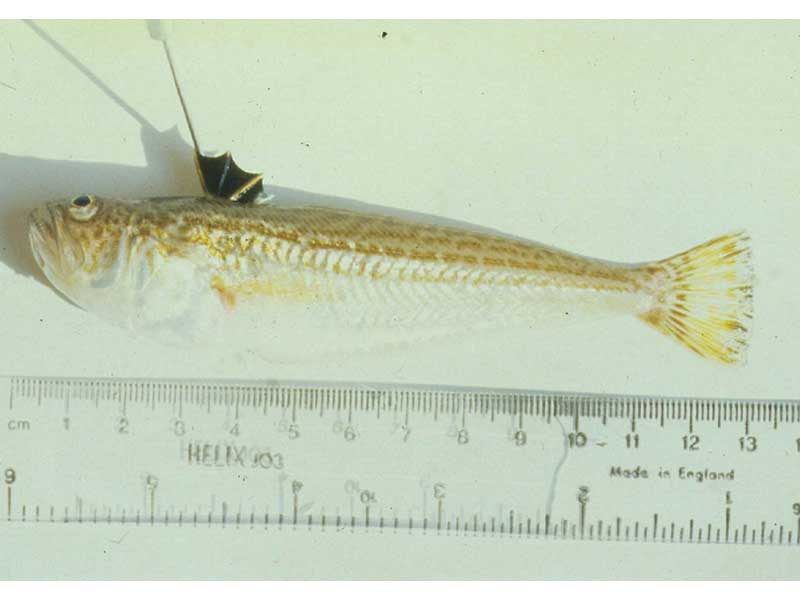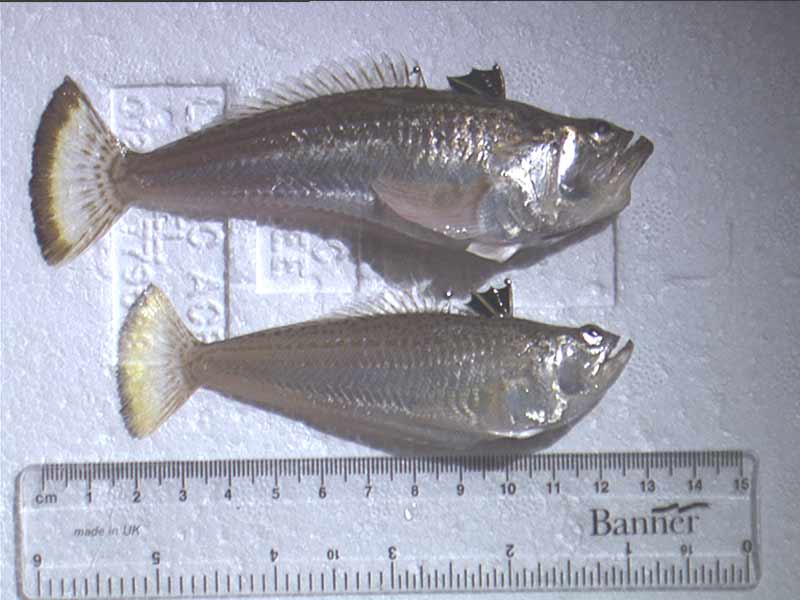Lesser weever fish (Echiichthys vipera)
Distribution data supplied by the Ocean Biodiversity Information System (OBIS). To interrogate UK data visit the NBN Atlas.Map Help
| Researched by | Paolo Pizzolla | Refereed by | Admin |
| Authority | (Cuvier, 1829) | ||
| Other common names | - | Synonyms | Trachinus vipera (Cuvier, 1829) |
Summary
Description
The lesser weever fish has a short stout body and grows up to 14cm in length. It has a large sloping mouth and pointed snout with eyes high on the head. The first dorsal fin is triangular and entirely black with an elongated first spine on the male. The second dorsal and anal fins extend almost to the tail and the pectoral fins are large and paddle shaped. The gill covers have a long spine pointing backwards. The fish is yellowish brown with a paler underside.
Recorded distribution in Britain and Ireland
Found all around Britain, most abundant in the south and west.Global distribution
-Habitat
Common on clean sandy bottoms from the low water mark to the shallow sub-littoral down to 50 m. The species lives buried in the sand with only the head and back uncovered. The species is probably most active at night.Depth range
-Identifying features
- Oblique upward pointing mouth.
- Small, black first dorsal fin.
- Long second dorsal fin.
- Large paddle shaped pectoral fins.
- Yellowish brown in colour with a paler underside.
Additional information
The spines of the first dorsal fin and gill covers release a poison that gives an extremely painful sting to bathers or fishermen treading on the buried fish. The name "weever" is derived from the Old French word "wirve," meaning serpent or dragon, and reflects the venomous nature of the fish (OED, 1990).
Listed by
- none -
Bibliography
Dipper, F., 2001. British sea fishes (2nd edn). Teddington: Underwater World Publications Ltd.
Fish, J.D. & Fish, S., 1996. A student's guide to the seashore. Cambridge: Cambridge University Press.
Hayward, P., Nelson-Smith, T. & Shields, C. 1996. Collins pocket guide. Sea shore of Britain and northern Europe. London: HarperCollins.
Hayward, P.J. & Ryland, J.S. (ed.) 1995b. Handbook of the marine fauna of North-West Europe. Oxford: Oxford University Press.
Howson, C.M. & Picton, B.E., 1997. The species directory of the marine fauna and flora of the British Isles and surrounding seas. Belfast: Ulster Museum. [Ulster Museum publication, no. 276.]
JNCC (Joint Nature Conservation Committee), 1999. Marine Environment Resource Mapping And Information Database (MERMAID): Marine Nature Conservation Review Survey Database. [on-line] http://www.jncc.gov.uk/mermaid
Datasets
Environmental Records Information Centre North East, 2018. ERIC NE Combined dataset to 2017. Occurrence dataset: http://www.ericnortheast.org.ukl accessed via NBNAtlas.org on 2018-09-38
Fenwick, 2018. Aphotomarine. Occurrence dataset http://www.aphotomarine.com/index.html Accessed via NBNAtlas.org on 2018-10-01
Fife Nature Records Centre, 2018. St Andrews BioBlitz 2014. Occurrence dataset: https://doi.org/10.15468/erweal accessed via GBIF.org on 2018-09-27.
Isle of Wight Local Records Centre, 2017. IOW Natural History & Archaeological Society Marine Records. Occurrence dataset: https://doi.org/10.15468/7axhcw accessed via GBIF.org on 2018-09-27.
Kent & Medway Biological Records Centre, 2017. Fish: Records for Kent. Occurrence dataset https://doi.org/10.15468/kd1utk accessed via GBIF.org on 2018-09-27.
Kent Wildlife Trust, 2018. Kent Wildlife Trust Shoresearch Intertidal Survey 2004 onwards. Occurrence dataset: https://www.kentwildlifetrust.org.uk/ accessed via NBNAtlas.org on 2018-10-01.
Merseyside BioBank., 2018. Merseyside BioBank (unverified). Occurrence dataset: https://doi.org/10.15468/iou2ld accessed via GBIF.org on 2018-10-01.
National Trust, 2017. National Trust Species Records. Occurrence dataset: https://doi.org/10.15468/opc6g1 accessed via GBIF.org on 2018-10-01.
NBN (National Biodiversity Network) Atlas. Available from: https://www.nbnatlas.org.
OBIS (Ocean Biodiversity Information System), 2025. Global map of species distribution using gridded data. Available from: Ocean Biogeographic Information System. www.iobis.org. Accessed: 2025-07-01
Citation
This review can be cited as:
Last Updated: 11/10/2002




